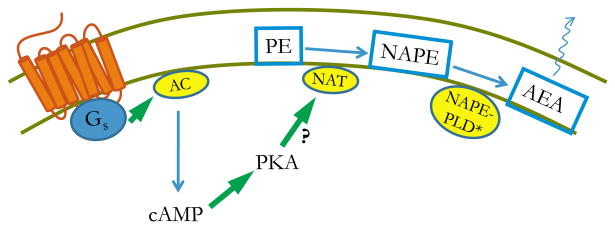Fig. 3.
The putative mechanism by which the activation of a Gs-coupled receptor may enhance endocannabinoid production. Activation of a Gs-coupled receptor leads to the activation of the adenylyl cyclase enzyme, which produces cAMP. cAMP can activate PKA, which, through the phosphorylation of an as yet unidentified target, may enhance the production of eCBs, principally that of anandamide. As the rate-limiting step in AEA-biosynthesis is catalyzed by NAT, it would seem reasonable that PKA exerts its potentiating effect on NAT. However, no direct evidence demonstrating this effect is available at the moment. Abbreviations: cAMP, cyclic AMP; PKA, protein kinase A; AC, adenylyl cyclase; AEA, N-arachidonoyl-ethanolamine (anandamide); NAPE, N-arachidonoyl-phosphatidylethanolamine; NAPE-PLD, NAPE-specific phospholipase D; NAT, N-acyltransferase; PE, phosphatidylethanolamine. * Indicates alternative pathways for anandamide production (see text for details).

